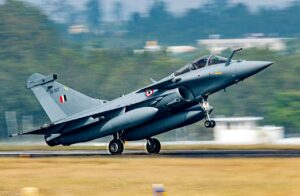Chief of Defence Staff of the Indian Armed Forces General Anil Chauhan on Saturday categorically rejected Pakistan’s claims that it had shot down six Indian warplanes during Operation Sindoor, calling the information “absolutely incorrect”.
The CDS added that “what is important is that, not the jet being down, but why they were being downed”.
“The good part is that we are able to understand the tactical mistake which we made, remedy it, rectify it, and then implement it again after two days and flew all our jets again, targeting at long range,” General Chauhan said during an interview with Bloomberg TV when asked about Pakistan’s claims.
The India-Pakistan Aerial Conflict: A Brief Overview
The conflict erupted after an attack in Indian-administered Kashmir on May 7, 2025, which led to the loss of 26 Indian soldiers. In response, the Indian government launched airstrikes on targets within Pakistan’s borders, marking a significant escalation in the long-standing tensions between the two nuclear-armed neighbors.
During this exchange, both India and Pakistan claimed to have downed enemy aircraft. Pakistan’s military reported shooting down several Indian fighter jets, including state-of-the-art models such as the Rafale and Mirage 2000. However, India’s official statements have yet to confirm the exact number of aircraft lost, leading to a range of conflicting narratives from both sides.
Expert Opinion: Was Full Clearance Given?
A recent analysis by a defense expert suggested that the IAF might have acted without the necessary clearance during the aerial engagement. The expert emphasized that, in military operations of this magnitude, coordination between different levels of command is essential to prevent tactical errors and ensure mission success.
In particular, the expert pointed out the lack of communication between key decision-making units during the clash. While some argue that swift action was necessary to defend Indian airspace, others contend that clearances and operational orders should have been carefully reviewed before any engagement.

India’s Acknowledgment of Losses
In the aftermath of the conflict, India’s Chief of Defence Staff (CDS), General Anil Chauhan, confirmed that India had indeed suffered losses in the conflict. However, he also downplayed the significance of these losses, stressing that the precise number of downed aircraft was not the primary concern. According to General Chauhan, the important factor was the fact that the Indian Air Force had already corrected any tactical mistakes and adapted its strategies for future operations.
His statements have sparked a larger debate among military analysts, with some questioning the adequacy of the IAF’s response and its readiness to handle such high-pressure situations. Furthermore, the suggestion that tactical mistakes were corrected quickly has left some wondering whether these mistakes were avoidable in the first place, had proper clearance and communication been in place.
The Need for Effective Command Structures
The expert’s assertion that the IAF may not have had full clearance before the operation highlights the importance of robust command structures in military operations. In any high-stakes engagement, especially one involving multiple fighter jets and sophisticated technology, ensuring that every action is sanctioned and well-coordinated is crucial.
A breakdown in the chain of command, particularly in a high-pressure situation, can have devastating consequences, including the loss of aircraft and personnel. Experts argue that a failure to communicate clearly, or a lack of proper authorization before critical decisions are made, can lead to confusion on the ground and in the air.
Political and Public Response
The ongoing investigation into the aerial clash has also sparked political controversy, with opposition leaders calling for more transparency from the government. They argue that a detailed account of the airstrike’s failures and successes is necessary for the public to fully understand the nature of the operation.
In addition, some have suggested that the Indian government needs to reconsider its approach to military transparency, especially when dealing with such a sensitive issue. As the public demands more information, the government faces increasing pressure to clarify the circumstances surrounding the loss of its aircraft.
Conclusion
As the investigation continues into the events of the May 2025 India-Pakistan aerial clash, several questions remain unanswered. The suggestion that the Indian Air Force may have acted without full clearance raises important issues about military protocol, command structures, and the importance of clear communication during high-pressure operations. The lessons learned from this incident could be crucial in shaping India’s future military strategies and ensuring that similar mistakes are not repeated.
In the coming weeks, more information is expected to surface, and it is hoped that these findings will lead to a more secure and transparent approach to military operations moving forward.
Key Takeaways:
Operational Clearance: A defense expert has suggested that the Indian Air Force may not have received full clearance during the aerial clash with Pakistan.
Losses Confirmed: India has acknowledged the loss of fighter jets but emphasized corrective actions in its response strategy.
Command and Coordination: Experts stress the importance of clear communication and authorization in military operations to avoid errors.
Political Scrutiny: The loss of aircraft has raised calls for greater transparency from the Indian government regarding the operation’s details.
Ongoing Investigation: The investigation into the aerial clash is ongoing, and more information is expected to emerge in the coming weeks.
Follow us at : https://x.com/FilmyScoop7
instagram : https://www.instagram.com/filmyscoop_7772?igsh=MXI0NW4wMXRidmsxYw==


